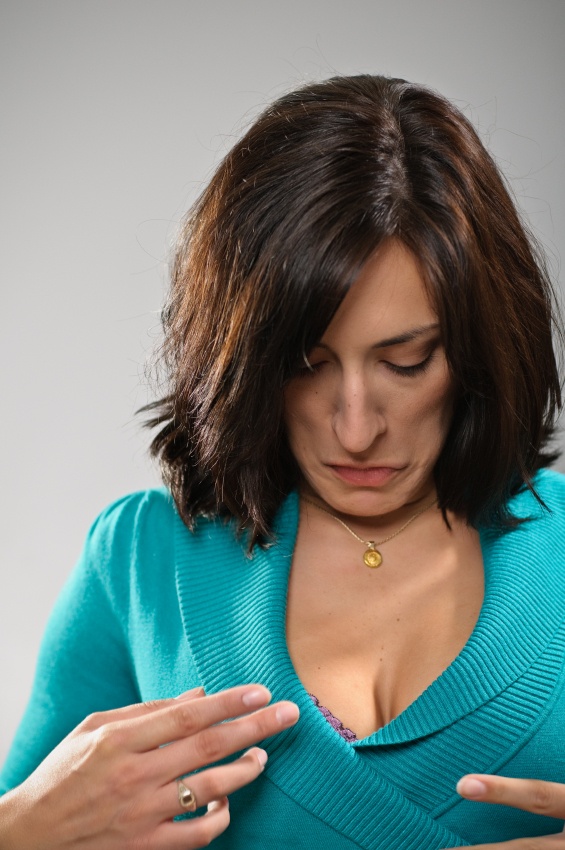Horizontal details or lines in clothing shorten and widen the body because the eye follows the direction of the lines. Most horizontal lines are created by a contrast in colour or texture, as in prints, design details, accessories or tops and bottoms in contrasting colours or tones. Although their power to make you look heavier may tempt you to avoid them altogether, a wardrobe with no horizontal details would be very boring. Instead strategically use them to your advantage. To balance full hips use horizontal details like bateau necklines, yokes and other details on the upper part of the body. This will make your shoulders look wider and your hips will look slimmer.
Tag Archives: Wardrobe
How to Change Your Body Shape
When we refer to body shape or body type we are usually referring to the silhouette of the body formed by the structure of the hips, shoulders and waist. These three body parts form the shape of the body. There are many different ways that we can describe these body shapes. Some image professionals use geometrical labels. Some personal image experts use letters. And there are many other labels that describe body shapes and types. However, if you consider what they are saying it comes down to the following:
- The shoulders are wider than the hips
- The hips are wider than the shoulders
- The hips and shoulders are the same width and the waist is much smaller
- The hips and shoulders are the same width and the waist is not much smaller
- The hips and shoulders are the same and the waist is larger
Once you have determined your body shape it will make it much easier to decide if you want to dress to emphasize or to camouflage your body shape.
How to Accentuate Your Body Shape
The body type is based on the natural shape of the body. It is formed by the bone structure of the hips and the shoulders. This is what determines the body type or body shape. By dressing in clothes that follow the natural lines of the body the best features will be accentuated.
How Much Cleavage is Too Much Cleavage?
As an image consultant, companies often hire me to speak to their employees about professional dress. One of the top areas of concern for companies is cleavage.
How much cleavage is too much cleavage?
Because we are all built differently it’s difficult to give exact measurements. However, the general rule for a professional look is that your neckline should be no lower than 2 finger widths above where your cleavage starts.
In a social setting with friends, choose the depth of your neckline based on your level of confidence, the impression you are trying to make and where you want attention focused.
The Wrong Underwear
You know, we have all seen it… the sagging or bumpy breasts, jiggling rear ends and the underwear straps that show. These are all examples of the wrong underwear. Although, the wrong undergarments will sabotage your image in any situation, it is even more of an issue at work. Why? If the desired focus is your product or service and you want to appear credible in your presentation of that product or service, then the focus should be on that product or service. The wrong underwear is not only distracting, it can make others uncomfortable. In other words, when at work, do you want people to be thinking about your underwear or what a great job you and your company can do for them? The right underwear will keep everything in place and help keep attention focused on what’s important at the time. Your silhouette will appear smoother and you will look slimmer.
Wardrobe Malfunctions – Stay-ups that Don’t Stay Up
Ever have one of those really embarrassing moments? Although many of us think wardrobe malfunctions and mishaps only happen to celebrities like Britney Spears and Janet Jackson, it happens to all of us at one time or another… And recently it happened to me.
I was wearing stay-up hosiery. The kind with the silicone at the top, which is supposed to keep the hosiery in place. I was being escorted to my car by someone that I didn’t know very well, when suddenly I could feel one of my stockings sliding down my leg. How embarrassing!!! Yes, even professional image consultants have their embarrassing moments.
Although there really are not guarantees, the stay-ups are in good condition, they are more likely to stay put. To keep them in good condition longer. Wash them in cold water with mild detergent and avoid the dryer.
Don’t try to extend their life. As soon as the silicone starts to peal off, it’s time for a new stocking. The nice thing about stay-ups though is that often only one is ready for the garbage. By buying the same brand in the same colour, you mix and match as needed.
Another thing to consider is what you have on you skin. They tend to stick better if they are clean, and worn on clean skin without any creams, lotions or powders.
If you have any other suggestions to keep your stay-ups from malfuncting, I would love to hear about them.
Mixing Metals in Your Outfit ~Faux Pas or Fabulous?
A workshop attendee recently asked me what the rule is for wearing different metals at the same time.
The rule for wearing gold and silver together used to be very strict – Don’t Do It!
The thought was that jewellery metal should match. Matching jewellery sets were very common because they made coordinating your outfit very easy.
These days many of the rules of dressing have relaxed, and so has the rule about mixing metals. Now, it is more about the overall look and personality of the outfit being coordinated rather than just one element. Although wearing the same metal will appear more classic than mixing metals, a more important question to ask would be, “Does the personality of the jewellery go with the personality of the outfit?” If the answer is, “yes”, then go for it.
The Most Slimming Colour Combination
As an image consultant, clients often ask me how to wear colour in a way that will help them look slimmer.
The most slimming colour combinations are when dressing in monochromatic colour schemes: This colour scheme is created by dressing in one colour and its own variations A simple way of achieving this is by tinting (adding white), toning (adding grey or the colour’s opposite in the colour wheel, its complement on the colour wheel), or shading (adding black). This creates different values and intensities of the same colour. When worn, it is commonly known as “tone-on-tone” dressing.
When used in a wardrobe, monochromatic colour schemes have a slimming effect and can make the wearer look taller.
They also create a harmonious effect and make the wearer come across as elegant and refined.
The unfortunate thing about dressing in monochromatic colour schemes is that sometimes they can look boring. One way to remedie this is by accessorizing with jewellery or with an accessory such as a scarf that adds a small splash of another colour. This will create a focal point and draw attention and add interest. When using a focal point in your wardrobe, be aware of where your focal point is drawing the attention. I always recommend focal points close to the face. This will draw attention to your face and away from less flattering areas of the body.
How to Dress in Contrasting Colour Schemes
Clothing worn in contrasting colours combinations can appear very strong and sometimes hard on the eyes. An example of this would be dressing in a wardrobe combination of true violet and true yellow. Although this example contains complementary colours which are across from each other on a colour wheel, contrasting colour schemes are a combination of 2 or more colours that are on opposing sides of the colour wheel.
When wearing contrasting colours they tend to look best when worn in different intensities and example of this would be dressing in one dark; one light and one bright colour. This will draw attention to the brightest colour and the rest will complement that colour in the background.
A less dramatic version of this colour scheme is when the colours are all muted. Muted colours are more restful to the eye and appear more harmonious. In these wardrobe combinations they are also easier for most of us to wear and feel confident in.
How to Wear Colour Schemes Effectively
Throughout history, clothing colour combinations have been made more complicated than they need to be because fashion has always dictated what we should wear. However one of the nicest things about being a certified image consultant is that I get the privilege of showing my clients what colours look great with their colouring and what they should wear based on their personality, body shape and goals. Instead of focusing strictly on fashion, they are shown how to dress to look their personal best with colour.
In general there are two types of colour schemes – related colour combinations and contrasted colour combinations.
Related combinations are colour schemes where the colours have something in common. An example of this is an analogous colour scheme, where colours are side by side on a colour wheel. Monochromatic colour combinations are another related colour scheme. These colour combinations refer to colours that are made from the same base colour. The colour is altered by toning with grey, adding black, white or a small amount of another colour. When these colours are worn together they appear tone on tone.
Contrasting colour schemes are colours that have nothing in common. They are on different sides of a colour wheel. When side by side they draw attention to each other and stand out. Complementary colour schemes are the most contrasting. Complimentary colour schemes are when the colours are exact opposite to each other on a colour wheel. For example: red and green; blue and orange; violet and yellow; another example of a contrasting scheme is using three colours all equal distance apart on a colour wheel. An example of this is would be wearing red, yellow and blue together in a combination.
To look more elegant, softer, more approachable or harmonious opt for related colour combinations. To appear more dynamic, fun or energetic dress in contrasting combinations.
I highly recommend playing with colour and creating your own colour schemes with a box of Crayola crayons or paints. Find the combinations that interest your personality and suit your colouring. Incorporate them into your wardrobe and the way you dress.




